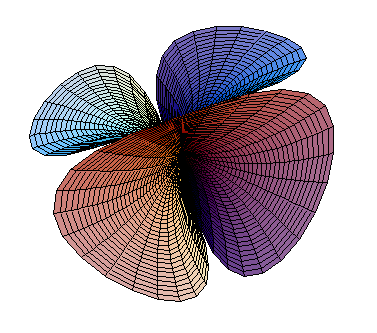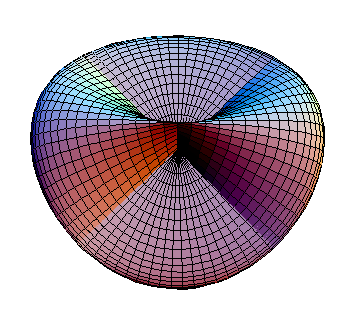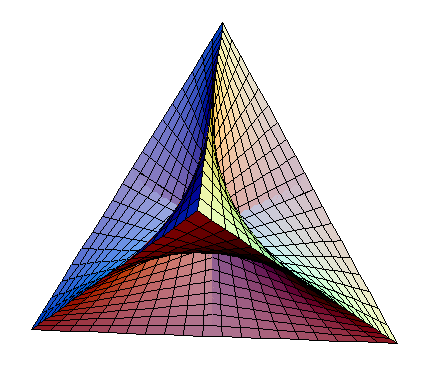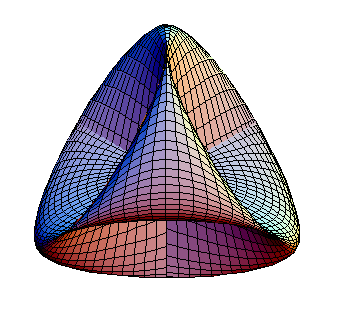Roman surface
|
|
The Roman surface (so called because Jakob Steiner was in Rome when he thought of it) is a self-intersecting immersion of the real projective plane into three-dimensional space, with an unusually high degree of symmetry.
The simplest construction is as the image of a sphere centered at the origin under the map f(x,y,z) = (yz,xz,xy). This gives us an implicit formula of
- <math> x^2 y^2 + y^2 z^2 + z^2 x^2 - r^2 x y z = 0. <math>
Also, taking a parametrization of the sphere in terms of longitude (θ) and latitude (φ), we get parametric equations for the roman surface as follows:
- x = r2 cos θ cos φ sin φ
- y = r2 sin θ cos φ sin φ
- z = r2 cos θ sin θ cos2 φ
The origin is a triple point, and each of the xy-, yz-, and xz-planes are tangential to the surface there. The other places of self-intersection are double points, defining segments along each axis which terminate in pinch points. The entire surface has tetrahedral symmetry. It is a particular type (called type 1) of Steiner surface.
Missing image
Romansurface.jpg
image:romansurface.jpg
| Contents |
Derivation of implicit formula
The points on a sphere have coordinates
- <math> (x, y, \sqrt{r^2 - x^2 - y^2}) <math>.
To these points, apply a transformation T defined as
- <math> T : (x, y, z) \rightarrow (y z, z x, x y) = (x', y', z') <math>
so that the transform of the sphere has points whose coordinates are
- <math> (x', y', z') = ( y \sqrt{r^2 - x^2 - y^2}, x \sqrt{r^2 - x^2 - y^2}, x y). \qquad \qquad (1) <math>
From equation (1) it follows that
- <math> x'^2 = y^2 (r^2 - x^2 - y^2), \qquad \qquad (2) <math>
- <math> y'^2 = x^2 (r^2 - x^2 - y^2), \qquad \qquad (3) <math>
- <math> z'^2 = x^2 y^2. \qquad \qquad (4) <math>
Equations (2), (3), and (4) combine through multiplication, producing these next three equations:
- <math> x'^2 y'^2 = x^2 y^2 (r^2 - x^2 - y^2)^2, \qquad (5) <math>
- <math> y'^2 z'^2 = x^4 y^2 (r^2 - x^2 - y^2), \qquad (6) <math>
- <math> z'^2 x'^2 = x^2 y^4 (r^2 - x^2 - y^2). \qquad (7) <math>
Equations (5), (6), and (7) combine through addition, producing
- <math> x'^2 y'^2 + y'^2 z'^2 + z'^2 x'^2 = x^2 y^2 (r^2 - x^2 - y^2)^2 + x^2 y^2 (x^2 + y^2) (r^2 - x^2 - y^2). \ <math>
Factor out the x2 y2 on the right side,
- <math> x'^2 y'^2 + y'^2 z'^2 + z'^2 x'^2 = x^2 y^2 [(r^2 - x^2 - y^2)^2 + (x^2 + y^2) (r^2 - x^2 - y^2)]. \ <math>
Now factor out <math> (r^2 - x^2 - y^2) <math> on the right side,
- <math> x'^2 y'^2 + y'^2 z'^2 + z'^2 x'^2 = x^2 y^2 (r^2 - x^2 - y^2) [(r^2 - x^2 - y^2) + x^2 + y^2] \ <math>
- <math> = r^2 x^2 y^2 (r^2 - x^2 - y^2) = r^2 x^2 y^2 z^2. \qquad \qquad (8)<math>
Multiplying the three components of equation (1) yields
- <math> x' y' z' = x^2 y^2 (r^2 - x^2 - y^2) = x^2 y^2 z^2, \ <math>
therefore equation (8) can be restated as
- <math> x'^2 y'^2 + y'^2 z'^2 + z'^2 x'^2 = r^2 x' y' z' \ <math>
where r is the radius of the original sphere; the Roman surface does not have a radius.
Derivation of parametric equations
Let a sphere have radius r, longitude φ, and latitude θ. Then its parametric equations are
- <math> x = r \, \cos \theta \, \cos \phi, <math>
- <math> y = r \, \cos \theta \, \sin \phi, <math>
- <math> z = r \, \sin \theta. <math>
Then, applying transformation T to all the points on this sphere yields
- <math> x' = y z = r^2 \, \cos \theta \, \sin \theta \, \sin \phi, <math>
- <math> y' = z x = r^2 \, \cos \theta \, \sin \theta \, \cos \phi, <math>
- <math> z' = x y = r^2 \, \cos^2 \theta \, \cos \phi \, \sin \phi, <math>
which are the points on the Roman surface. Let φ range from 0 to 2π, and let θ range from 0 to π/2.
Relation to the real projective plane
The sphere, before being transformed, is not homeomorphic to the real projective plane, RP2. But the sphere centered at the origin has this property, that if point (x,y,z) belongs to the sphere, then so does the antipodal point (-x,-y,-z) and these two points are different: they lie on opposite sides of the center of the sphere.
The transformation T converts both of these antipodal points into the same point,
- <math> T : (x, y, z) \rightarrow (y z, z x, x y), <math>
- <math> T : (-x, -y, -z) \rightarrow ((-y) (-z), (-z) (-x), (-x) (-y)) = (y z, z x, x y). <math>
If this were true for only one or small subset of points of the sphere, then these points would just be double points. But since it is true of all points, then it is possible to consider the Roman surface to be homeomorphic to a "sphere modulo antipodes", S2 / (x~-x), i.e. a sphere whose antipodal points are equivalent. The real projective plane is known to be homeomorphic to a sphere modulo antipodes, therefore the Roman surface is homeomorphic to RP2.
Structure of the Roman surface
The Roman surface has four bulbous "lobes", each one on a different corner of a tetrahedron.
A Roman surface can be constructed by splicing together three hyperbolic paraboloids and then smoothing out the edges as necessary so that it will fit a desired shape (e.g. parametrization).
Let there be these three hyperbolic paraboloids:
- x = y z,
- y = z x,
- z = x y.
These three hyperbolic paraboloids intersect externally along the six edges of a tetrahedron and internally along the three axes. The internal intersections are loci of double points. The three loci of double points: x = 0, y = 0, and z = 0, intersect at a triple point at the origin.
For example, given x = y z and y = z x, the second paraboloid is equivalent to x = y / z. Then
- <math> y z = {y \over z} <math>
and either y = 0 or z2 = 1 so that <math> z = \pm 1 <math>. Their two external intersections are
- x = y, z = 1;
- x = -y, z = -1.
Likewise, the other external intersections are
- x = z, y = 1;
- x = -z, y = -1;
- y = z, x = 1;
- y = -z, x = -1.
Let us see the pieces being put together. Join the paraboloids y = x z and x = y z. The result is shown in Figure 1.

|
|
The paraboloid y = x z is shown in blue and orange. The paraboloid x = y z is shown in cyan and purple. In the image the paraboloids are seen to intersect along the z = 0 axis. If the paraboloids are extended, they should also be seen to intersect along the lines
- z = 1, y = x;
- z = -1, y = -x.
The two paraboloids together look like a pair of orchids joined back-to-back.
Now run the third hyperbolic paraboloid, z = x y, through them. The result is shown in Figure 2.
| Missing image ThreeJointHyperbolicParaboloidsTopView.PNG Image:ThreeJointHyperbolicParaboloidsTopView.PNG |
|
On the West-Southwest and East-Northeast directions in Figure 2 there are a pair of openings. These openings are lobes and need to be closed up. When the openings are closed up, the result is the Roman surface shown in Figure 3.

|
|
A pair of lobes can be seen in the West and East directions of Figure 3. Another pair of lobes are hidden underneath the third (z = x y) paraboloid and lie in the North and South directions.
If the three intersecting hyperbolic paraboloids are drawn far enough that they intersect along the edges of a tetrahedron, then the result is as shown in Figure 4.

|
|
One of the lobes is seen frontally -- head on -- in Figure 4. The lobe can be seen to be one of the four corners of the tetrahedron.
If the continuous surface in Figure 4 has its sharp edges rounded out -- smoothed out -- then the result is the Roman surface in Figure 5.

|
|
One of the lobes of the Roman surface is seen frontally in Figure 5, and its bulbous -- balloon-like -- shape is evident.
If the surface in Figure 5 is turned around 180 degrees and then turned upside down, the result is as shown in Figure 6.
| Missing image RomanSurfaceSidewaysView.PNG Image:RomanSurfaceSidewaysView.PNG |
|
Figure 6 shows three lobes seen sideways. Between each pair of lobes there is a locus of double points corresponding to a coordinate axis. The three loci intersect at a triple point at the origin. The fourth lobe is hidden and points in the direction directly opposite from the viewer. The Roman surface shown at the top of this article also has three lobes in sideways view.
One-sidedness
The Roman surface is non-orientable, i.e. one-sided. This is not quite obvious. To see this, look again at Figure 3.
Imagine an ant on top of the "third" hyperbolic paraboloid, z = x y. Let this ant move North. As it moves, it will pass through the other two paraboloids, like a ghost passing through a wall. These other paraboloids only seem like obstacles due to the self-intersecting nature of the immersion. Let the ant ignore all double and triple points and pass right through them. So the ant moves to the North and falls of the edge of the world, so to speak. It now finds itself on the northern lobe, hidden underneath the third paraboloid of Figure 3. The ant is standing upside-down, on the "outside" of the Roman surface.
Let the ant move towards the Southwest. It will climb a slope (upside-down) until it finds itself "inside" the Western lobe. Now let the ant move in a Southeastern direction along the inside of the Western lobe towards the z = 0 axis, always above the x-y plane. As soon as it passes through the z = 0 axis the ant will be on the "outside" of the Eastern lobe, standing rightside-up.
Then let it move Northwards, over "the hill", then towards the Northwest so that it starts sliding down towards the x = 0 axis. As soon as the ant crosses this axis it will find itself "inside" the Northern lobe, standing right side up. Now let the ant walk towards the North. It will climb up the wall, then along the "roof" of the Northern lobe. The ant is back on the third hyperbolic paraboloid, but this time under it and standing upside-down. (Compare with Klein bottle.)
Double, triple, and pinching points
The Roman surface has four "lobes". The boundaries of each lobe are a set of three lines of double points. Between each pair of lobes there is a line of double points. The surface has a total of three lines of double points, which lie (in the parametrization given earlier) on the coordinate axes. The three lines of double points intersect at a triple point while lies on the origin. The triple point cuts the lines of double points into a pair of half-lines, and each half-line lies between a pair of lobes. One might expect from the preceding statements that there could be up to eight lobes, one in each octant of space which has been divided by the coordinate planes. But the lobes occupy alternating octants: four octants are empty and four are occupied by lobes.
If the Roman surface were to be inscribed inside the tetrahedron with least possible volume, one would find that each edge of the tetrahedron is tangent to the Roman surface at a point, and that each of these six points happens to be a Whitney singularity. These singularities, or pinching points, all lie at the edges of the three lines of double points, and they are defined by this property: that there is no plane tangent to surface at the singularity.
See also: Boy's surface.
External links
- An interactive 3D applet of a Roman surface, and also a discussion of the surface. (http://www.uta.edu/optics/sudduth/4d/nonorientable/steiners_roman_surface/steiners_roman_surface.htm)
- Ashay Dharwadker, Heptahedron and Roman Surface, Electronic Geometry Models, 2004. (http://www.eg-models.de/models/Surfaces/Algebraic_Surfaces/2003.05.001/)
